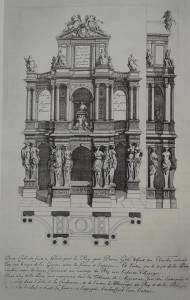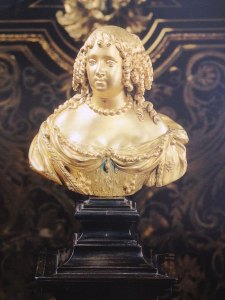Of all Louis XIV’s female companions, his wife is one of the least well known, yet her image survives in an exceptional gilt-bronze bust at Versailles
Women were the only weakness that trumped Louis XIV’s passion for art and war. A string of mistresses streaming in and out the royal bedchamber ensured that large parts of the kingdom were apprised of the sovereign’s manliness. Some of these mistresses, both the official and non-official, have received ample scholarly coverage, while the king’s most official female companion – his queen – has largely been forgotten. Marie-Thérèse of Spain, a Habsburg princess who married Louis XIV in June 1660 (both were 21), was too well behaved to be remembered. Unobtrusive and extremely pious, the woman who afforded the Bourbon dynasty a controversial claim to the Kingdom of Spain, challenged in the Spanish War of Succession, quickly discerned her role at court in ‘cohabitation’ with the king’s other companions. In the event, Marie-Thérèse was a perfect match who never attempted to distract from or indeed overshadow the Sun King’s radiance. The Duchess of Orléans, her sister-in-law, said she was ‘the best women in the world’ applying a superlative phrase similar to those used by contemporaries to describe the king; and Louis XIV himself mourned her premature death in July 1683, observing: ‘This the only sorrow she has given me.’

Pierre Gole’s Cabinets de la Paix for the Galerie d’Apollon (c. 1685), Corneil Gole. Kunstbibliothek, Berlin (OS 1242)
Louis XIV and Marie-Thérèse’s conjugal life coincided precisely with the exciting period during which the king and Jean-Baptiste Colbert, who died but weeks after the queen, transformed the visual art and luxury goods production in France. In the 1660s, Colbert either reformed or newly established the pillars of his art administration. Foreign envoys and artists were given tours of the Royal Academy of Painting and Sculpture, the Gobelins manufactories and the Royal Wardrobe, for ‘there is nothing that can display better the magnificence of the great princes than their superb palaces and the precious furnishings with which they are adorned’, to cite the 1663 Royal Decree naming the wardrobe’s new superintendent.
Probably the most spectacular items of furniture commissioned by Louis XIV were the two pairs of large cabinets – miniature triumphal arches comprising a wide array of exotic woods, hard stones and metals – installed by the Italian and Dutch ébénistes Domenico Cucci and Pierre Gole in the Apollo Gallery at the Louvre. Cucci’s cabinets were on theme of ‘Glory and Virtue’ and Gole’s on ‘War and Peace’. Although none of these extraordinary pieces of furniture survive, we are well informed of Gole’s ‘Cabinet of Peace’, thanks to a print made by his son Corneil. At their very centre the Gole cabinets bore a small gilt-bronze bust of Louis XIV and Marie-Thérèse respectively, but only that of the queen survives at Versailles – the bust of the king appears to have vanished rather mysteriously in the 1930s. The queen’s bust deserves a special place in the history of French decorative arts. Cast in around 1665, it stands at the beginning of a long tradition of gilt-bronze or ‘ormolu’ decorations pivotal to French furniture of the 18th century and arguably culminating in jewel-like mounts such as those produced by Pierre Gouthière for Jean-Henri Riesener.

Monument to Queen Marie-Thérèse of France (1666), attributed to Hyacinthe Cucci. Musée national du Château de Versailles (MV 6926)
We still know relatively little about the beginnings of gilt-bronzes in France. The then predominant and very strict system of guilds defining exactly who was allowed to produce what always struggled with the incorporation of new materials and techniques. The casting, chasing and gilding of bronzes led to continuous disputes and rivalries among Parisian craftsmen that would last throughout the 18th century. Domenico Cucci received the licence of a ‘fondeur en bronze’ to produce his own gilt-bronzes only after he had arrived at the Gobelins in 1664, while Gole does not appear ever to have held such a privilege. The present bust is attributed to Domenico’s brother Hyacinthe, and it is likely that the Cucci workshops supplied Gole with many ormolu ornaments, which he was probably not entitled to cast himself.
This small bust is not only a unique vestige of the Sun King’s most ambitious furniture commission, but a very rare example of very early louis-quatorze gilt-bronzes. Both Louis XIV’s pious consort, Queen Marie-Thérèse, and her intriguing counterfeit deserve to be better known. The sheer survival of the portrait bust may be testimony of the little appreciation lent to her so far – after all, there must be a reason why the king’s bust has disappeared, but the queen’s has not.
Wolf Burchard is a specialist on 17th- and 18th-century patronage. His online series about the legacy of Louis XIV expands on his feature article ‘Blinded by the Sun’ (first published in Apollo; March 2015).
Related Articles
Fit for a Sun King: the Latona Fountain reopens at Versailles (Caroline Rossiter)

Casting a Queen: Louis XIV’s forgotten wife
The Apollo Gallery at the Louvre
Share
Of all Louis XIV’s female companions, his wife is one of the least well known, yet her image survives in an exceptional gilt-bronze bust at Versailles
Women were the only weakness that trumped Louis XIV’s passion for art and war. A string of mistresses streaming in and out the royal bedchamber ensured that large parts of the kingdom were apprised of the sovereign’s manliness. Some of these mistresses, both the official and non-official, have received ample scholarly coverage, while the king’s most official female companion – his queen – has largely been forgotten. Marie-Thérèse of Spain, a Habsburg princess who married Louis XIV in June 1660 (both were 21), was too well behaved to be remembered. Unobtrusive and extremely pious, the woman who afforded the Bourbon dynasty a controversial claim to the Kingdom of Spain, challenged in the Spanish War of Succession, quickly discerned her role at court in ‘cohabitation’ with the king’s other companions. In the event, Marie-Thérèse was a perfect match who never attempted to distract from or indeed overshadow the Sun King’s radiance. The Duchess of Orléans, her sister-in-law, said she was ‘the best women in the world’ applying a superlative phrase similar to those used by contemporaries to describe the king; and Louis XIV himself mourned her premature death in July 1683, observing: ‘This the only sorrow she has given me.’
Pierre Gole’s Cabinets de la Paix for the Galerie d’Apollon (c. 1685), Corneil Gole. Kunstbibliothek, Berlin (OS 1242)
Louis XIV and Marie-Thérèse’s conjugal life coincided precisely with the exciting period during which the king and Jean-Baptiste Colbert, who died but weeks after the queen, transformed the visual art and luxury goods production in France. In the 1660s, Colbert either reformed or newly established the pillars of his art administration. Foreign envoys and artists were given tours of the Royal Academy of Painting and Sculpture, the Gobelins manufactories and the Royal Wardrobe, for ‘there is nothing that can display better the magnificence of the great princes than their superb palaces and the precious furnishings with which they are adorned’, to cite the 1663 Royal Decree naming the wardrobe’s new superintendent.
Probably the most spectacular items of furniture commissioned by Louis XIV were the two pairs of large cabinets – miniature triumphal arches comprising a wide array of exotic woods, hard stones and metals – installed by the Italian and Dutch ébénistes Domenico Cucci and Pierre Gole in the Apollo Gallery at the Louvre. Cucci’s cabinets were on theme of ‘Glory and Virtue’ and Gole’s on ‘War and Peace’. Although none of these extraordinary pieces of furniture survive, we are well informed of Gole’s ‘Cabinet of Peace’, thanks to a print made by his son Corneil. At their very centre the Gole cabinets bore a small gilt-bronze bust of Louis XIV and Marie-Thérèse respectively, but only that of the queen survives at Versailles – the bust of the king appears to have vanished rather mysteriously in the 1930s. The queen’s bust deserves a special place in the history of French decorative arts. Cast in around 1665, it stands at the beginning of a long tradition of gilt-bronze or ‘ormolu’ decorations pivotal to French furniture of the 18th century and arguably culminating in jewel-like mounts such as those produced by Pierre Gouthière for Jean-Henri Riesener.
Monument to Queen Marie-Thérèse of France (1666), attributed to Hyacinthe Cucci. Musée national du Château de Versailles (MV 6926)
We still know relatively little about the beginnings of gilt-bronzes in France. The then predominant and very strict system of guilds defining exactly who was allowed to produce what always struggled with the incorporation of new materials and techniques. The casting, chasing and gilding of bronzes led to continuous disputes and rivalries among Parisian craftsmen that would last throughout the 18th century. Domenico Cucci received the licence of a ‘fondeur en bronze’ to produce his own gilt-bronzes only after he had arrived at the Gobelins in 1664, while Gole does not appear ever to have held such a privilege. The present bust is attributed to Domenico’s brother Hyacinthe, and it is likely that the Cucci workshops supplied Gole with many ormolu ornaments, which he was probably not entitled to cast himself.
This small bust is not only a unique vestige of the Sun King’s most ambitious furniture commission, but a very rare example of very early louis-quatorze gilt-bronzes. Both Louis XIV’s pious consort, Queen Marie-Thérèse, and her intriguing counterfeit deserve to be better known. The sheer survival of the portrait bust may be testimony of the little appreciation lent to her so far – after all, there must be a reason why the king’s bust has disappeared, but the queen’s has not.
Wolf Burchard is a specialist on 17th- and 18th-century patronage. His online series about the legacy of Louis XIV expands on his feature article ‘Blinded by the Sun’ (first published in Apollo; March 2015).
Related Articles
Fit for a Sun King: the Latona Fountain reopens at Versailles (Caroline Rossiter)
Unlimited access from just $16 every 3 months
Subscribe to get unlimited and exclusive access to the top art stories, interviews and exhibition reviews.
Share
Recommended for you
Louis XIV: a round-up of exhibitions
Louis XIV’s tercentenary commemorated in exhibitions around the world
When the Sun Set: 300 Years since the Death of Louis XIV
The King is dead! Long live the King! Portraits of Louis XIV and his infant successor, Louis XV
Blinded by the Sun: The Age of Louis XIV
What is the cultural legacy of Louis XIV’s extravagant reign?